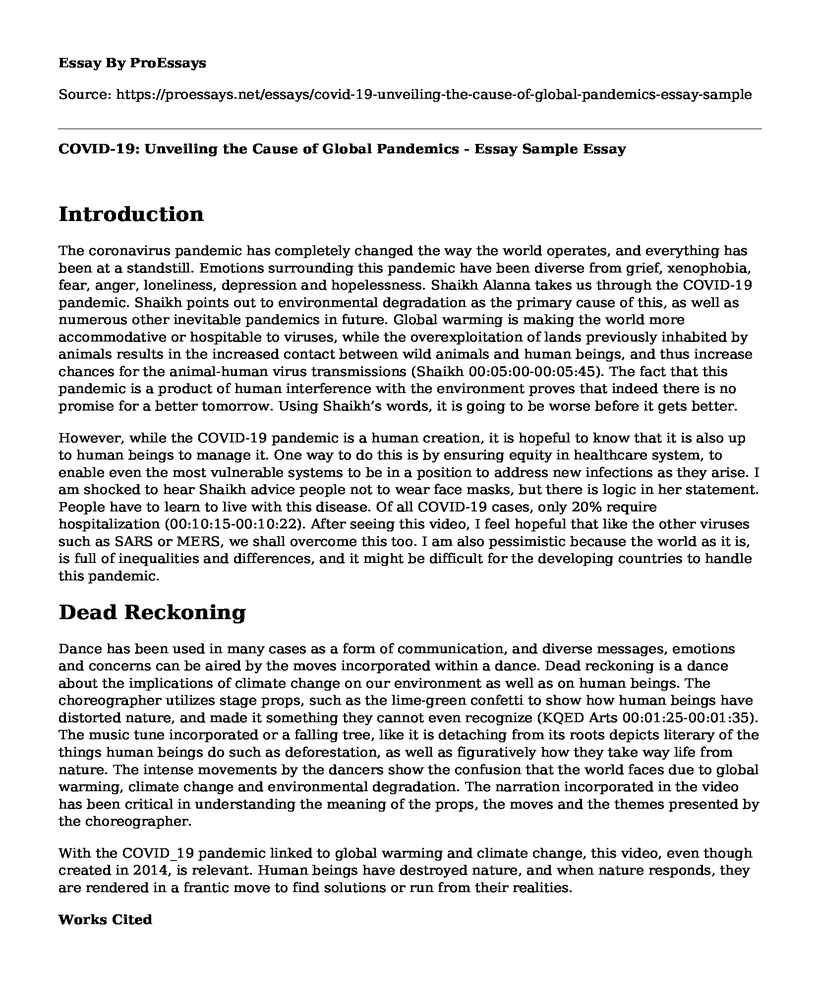Introduction
The coronavirus pandemic has completely changed the way the world operates, and everything has been at a standstill. Emotions surrounding this pandemic have been diverse from grief, xenophobia, fear, anger, loneliness, depression and hopelessness. Shaikh Alanna takes us through the COVID-19 pandemic. Shaikh points out to environmental degradation as the primary cause of this, as well as numerous other inevitable pandemics in future. Global warming is making the world more accommodative or hospitable to viruses, while the overexploitation of lands previously inhabited by animals results in the increased contact between wild animals and human beings, and thus increase chances for the animal-human virus transmissions (Shaikh 00:05:00-00:05:45). The fact that this pandemic is a product of human interference with the environment proves that indeed there is no promise for a better tomorrow. Using Shaikh’s words, it is going to be worse before it gets better.
However, while the COVID-19 pandemic is a human creation, it is hopeful to know that it is also up to human beings to manage it. One way to do this is by ensuring equity in healthcare system, to enable even the most vulnerable systems to be in a position to address new infections as they arise. I am shocked to hear Shaikh advice people not to wear face masks, but there is logic in her statement. People have to learn to live with this disease. Of all COVID-19 cases, only 20% require hospitalization (00:10:15-00:10:22). After seeing this video, I feel hopeful that like the other viruses such as SARS or MERS, we shall overcome this too. I am also pessimistic because the world as it is, is full of inequalities and differences, and it might be difficult for the developing countries to handle this pandemic.
Dead Reckoning
Dance has been used in many cases as a form of communication, and diverse messages, emotions and concerns can be aired by the moves incorporated within a dance. Dead reckoning is a dance about the implications of climate change on our environment as well as on human beings. The choreographer utilizes stage props, such as the lime-green confetti to show how human beings have distorted nature, and made it something they cannot even recognize (KQED Arts 00:01:25-00:01:35). The music tune incorporated or a falling tree, like it is detaching from its roots depicts literary of the things human beings do such as deforestation, as well as figuratively how they take way life from nature. The intense movements by the dancers show the confusion that the world faces due to global warming, climate change and environmental degradation. The narration incorporated in the video has been critical in understanding the meaning of the props, the moves and the themes presented by the choreographer.
With the COVID_19 pandemic linked to global warming and climate change, this video, even though created in 2014, is relevant. Human beings have destroyed nature, and when nature responds, they are rendered in a frantic move to find solutions or run from their realities.
Works Cited
KQED Arts. Fighting climate change with dance. April 11, 2016. Accessed on https://www.youtube.com/watch?v=1N41d7BjShY&t=320s
Shaikh Alanna. Coronavirus is our future. TEDxSMU. March 2020. Accessed on https://www.ted.com/talks/alanna_shaikh_coronavirus_is_our_future?language=en
Cite this page
COVID-19: Unveiling the Cause of Global Pandemics - Essay Sample. (2023, Aug 14). Retrieved from https://proessays.net/essays/covid-19-unveiling-the-cause-of-global-pandemics-essay-sample
If you are the original author of this essay and no longer wish to have it published on the ProEssays website, please click below to request its removal:
- Dangerous Consumption: Is the Consumer or the Company to Blame?
- Three Ways in Which Public Health England (PHE) Attempts to Minimize Inequalities in Health
- Paper Example on Hypertension
- Pediatric Heart Failure: Causes, Clinical Manifestations, & Challenges - Essay Sample
- Essay on Visiting Hours in ICU: Limitations on Family Care and Life-Critical Decisions
- Covid-19: US Battle for Socio-Economic and Political Stability - Essay Sample
- Essay on Urban Governance: Examining Diffuse Authority & Unspoken Conventions







